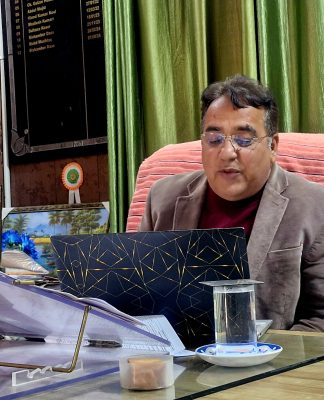The Indus Water Treaty (IWT) is a water-distribution treaty between India and Pakistan signed on September 19, 1960. The treaty was signed by the then Prime Minister Jawaharlal Nehru and Pakistan’s President Ayub Khan. It was brokered by the World Bank (International Bank for Reconstruction and Development).
The Indus Waters Treaty (IWT) deals with river Indus and its five tributaries, which are classified in 2 categories:
Eastern rivers:
Sutlej Beas Ravi
Western rivers:
Jhelum Chenab Indus
According to treaty, all the water of eastern rivers shall be available for unrestricted use in India.India should let unrestricted flow of water from western rivers to Pakistan.It doesn’t mean that India can’t use western river’s water. The treaty says that India can use the water in western rivers in “non-consumptive” needs. Here non consumptive means we can use it for irrigation, storage and even for electricity production. (But India has not fully utilized this provision so far).The treaty allocates 80% of water from the six-river Indus water system to Pakistan.A Permanent Indus Commissionwas set up as a bilateral commission to implement and manage the Treaty.Though Indus originates from Tibet, China has been kept out of the Treaty.
India-Pak Disputes Connecting Indus: Timeline
1948: India cuts off supply in most canals that went to Pakistan. But restores it later.1951: Pakistan accuses India of cutting water to many of its villages.1954: Word Bank comes up with a water-sharing formula for two countries.1960: Indus Waters Treaty signed.1970’s: India starts building hydropower projects in Kashmir. Pakistan raises concern.1984: Pakistan objects over India building Tulbul barrage on Jhelum. India stops it unilaterally.2007: Pakistan raises concern over Kishanganga hydroelectric plant.2008: Lashkar-e-Taiba starts campaign against India. Its chief Hafiz Saeed accuses India of water terrorism.2010: Pakistan accuses India of choking water supply consistently.2016: India reviews working of Indus Waters Treaty linking it with cross-border terrorism (Uri attack).
Why Indus Water Treaty in news?
Indus Water Treaty is considered to be one of the most successful water-sharing endeavours in the world today. For 56 years, both India and Pakistan are peacefully sharing the water of Indus and its tributaries, thanks to The Indus Water Treaty (IWT).Because of the confrontations between India and Pakistan over other issues, the water treaty naturally comes into picture.After the Uri cross-border attack by Pakistan in 2016, Indian Prime Minister Narendra Modi had said “Blood and Water cannot flow simultaneously.”There are issues between India and Pakistan, but there has been no fight over water after the Treaty was ratified. Most disagreements and disputes have been settled via legal procedures, provided for within the framework of the treaty.
Can India stop water flow to Pakistan?
No. Not as per the treaty.What India can do is to reduce the water flow to Pakistan by utilizing the provisions of the treaty.But any project which may affect water flow will take time for implementation, considering the cost and objections involved. Pakistan has reportedly objected to five Indian hydro power projects, and the Wullar Barrage (Tulbul Navigation Project) which must be settled before India can resume work on them.
Can India walk out of the pact unilaterally?
The treaty has no provision for either country unilaterally walking out of the pact. Article XII of the treaty says “The provisions of this Treaty, or, the provisions of this Treaty as modified under the provisions of Paragraph (3), shall continue in force until terminated by a duly ratified treaty concluded for that purpose between the two governments.” Still if India wants to go about abrogating it, the country should abide by the 1969 Vienna convention on the law of treaties.
Had the Indian President signed the treaty?
The validity of the treaty is being challenged in court as it was signed by the Prime minister of India who is not head of the Indian republic. The President of India is the official head of the state.
Tulbul Project: By India
The Tulbul project is a “navigation lock-cum-control structure” at the mouth of the lake, located on the Jhelum river. It is a key intra-state channel to ferry state’s goods and people.The idea is to ensure year-round navigation along the 20-km stretch from Anantnag to Srinagar and Baramulla, and on the 22 km-stretch between Sopore and Baramulla that becomes non-navigable in winter with water depth of only 2.5 ft (to sustain navigation through the year a minimum depth of water in the lake is necessary).The project envisages water release from lake to maintain minimum draught of 4.5 feet in Jhelum.India had started constructing a 439 feet long barrage at the lake’s mouth.India unilaterally suspended the Tulbul project (Islamabad calls it Wullar Barrage) in 1987 after Pakistan objected.The decision to review the suspension signalled the Modi government’s intent to revive it irrespective of Pakistan’s protests.Implication: India gets to control Jhelum water, but that may impact Pakistan agriculture. The project can create problems for Pakistan’s triple-canal project that connects Jhelum-Chenab with Upper Bari Doab Canal. With a barrage, India controls release of water into Jhelum, which could trigger a flood or drought in POK and Pakistan.
Left Bank Outfall Drain (LBOD) Project: by Pakistan
Without taking consent from India, Pakistan has constructed Left Bank Outfall Drain (LBOD) project passing through the Great Rann of Kutch area (Gujarat, India) with the assistance from the world bank. The purpose of LBOD is to bypass the saline and polluted water which is not fit for agriculture use to reach sea via Rann of Kutch area without passing through its Indus delta.The LBOD water is planned to join the sea via Sir Creek but LBOD water is entering Indian territory due to many breaches in its left bank caused by floods. Water released by the LBOD is enhancing the flooding in India and contaminating the quality of water bodies which are source of water to salt farms spread over vast area.Gujarat state of India being the lower most riparian part of Indus basin, Pakistan is bound to provide all the details of engineering works taken up by Pakistan to India as per the provisions of the treaty and shall not proceed with the project works till the disagreements are settled by arbitration process.
Indus Water Treaty: Matters Beyond India and Pakistan
Indus originates from Tibet in China. If China decides to stop or change the flow of the river, it will affect both India and Pakistan.Climate change is causing melting of ice in Tibetan plateau, which scientists believe will affect the river in future.
Should India violate a bilateral treaty with Pakistan because of cross-border attacks?
The Indus Water Treaty (IWT) was meant to reduce hostilities between India and Pakistan. It should be kept in the same spirit.India has always dealt with security and water issues separately with Pakistan.80% of Pakistan’s 21.5 million hectares of farmland is irrigated by river Indus and its tributaries. Reducing the water flow to Pakistan will unleash havoc there (especially in Punjab and Sindh province).Breaking the Indus Water Treaty doesn’t make any sense as India at present does not have enough infrastructure to use the additional water available. It may create flood in the Kashmir valley as well.The decision of not giving water to Pakistan may further enrage the terror elements in the country, making them intensifying their attacks on India.Not respecting the Indus Water Treaty, may invite global condemnation to India as the treaty is an international agreement.Neighbours like Nepal and Bangladesh with whom we have water treaties may turn skeptical.There are concerns that China may also block the water of Brahmaputra to Assam.The Kashmir issue will get a whole new dimension if India withdraws from the treaty. Not only this, it would trigger the formal beginning of water warsIndia, aspiring for a seat in the UNSC, should safeguard rather than violate bilateral treaties.The approach of government should be to utilize provisions available in Indus Water Treaty itself. But building infrastructure across Indus will take time.
Summary
India has never used our rights on the western rivers. Under the Indus Water Treaty, we can make use of the waters of the western rivers for irrigation, storage, and even for producing electricity, in the manner specified. If we just do what we are entitled to under the Treaty, it would be enough to send jitters through Pakistan. It would be a strong signal without doing anything drastic.

















































